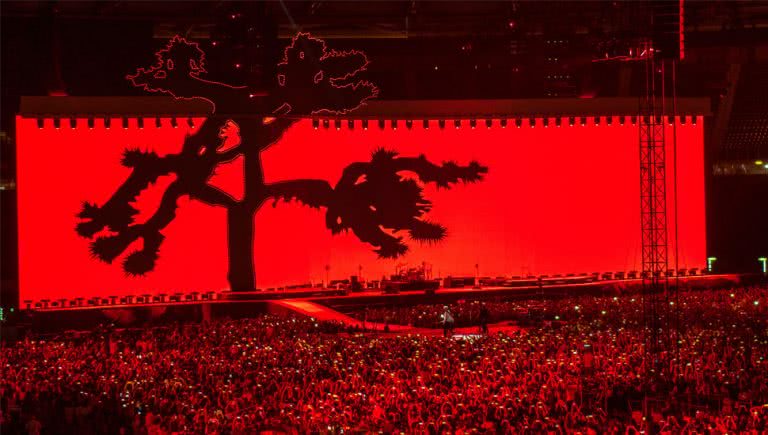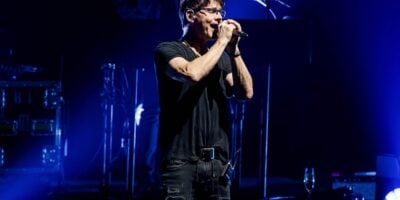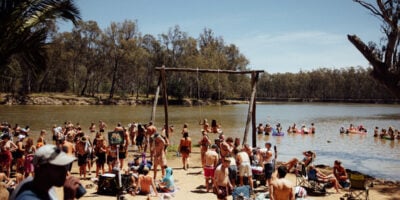This November, U2 is returning to Australia for the first time since 2010. To celebrate the historic occasion, we will revisit the band’s tour history and dive into the technology of their upcoming concert to tell you what to expect from “the greatest rock’n’roll band in the world.”
From school ground beginnings to making it big-time
These four Irish lads have certainly gone far since they met at Mount Temple Comprehensive School in the late ’70s. A band that started as an interesting post-punk phenomenon became, in just a decade, one of the biggest pop sensations the music business has ever seen. Generation X and Millennials didn’t have Elvis, The Beatles, or Led Zeppelin, but we can sure say we had U2.
Arguably, no band since The Beatles has achieved such a combination of popular appeal, commercial success, artistic relevance, and social impact. In times like ours, when rock’n’roll music has been pushed to the fringes of mainstream charts and is almost considered now as niche, it’s not crazy to say U2 is the last of the supergroups.
The band has managed to stay relevant for almost four decades thanks in part to their uncanny ability to reinvent themselves. In fact, they’ve had so many iterations your perception of the band depends on the decade in which you first heard them.
In the early ’80s, they were a sort of Joy Division light, well respected in the underground scene, and a sensation at small local venues for the intensity of their performances.
They played at school auditoriums, bars or unusual locales like Dublin’s Dandelion Market. Bono had a strange bushy mullet, The Edge didn’t wear hats, Larry Mullen Jr. seemed to use lots of hair conditioner and Adam Clayton rocked a gigantic orange afro.
By the mid-80s they had developed their unique brand of alternative rock and had already earned on the road the reputation of being one of the most exciting live bands of the rock circuit.
After their first gigs in the United States, they began to progressively play larger venues, moving from clubs to music halls to arenas.
It’s during this time that they introduce strong socio-political themes into their act. Ireland was going through the thick of The Troubles, and their live presence was passionate, aggressive and almost defiant. In contrast, their set-up was austere, featuring only three white flags as props on stage.
During their shows, fans often threw Irish flags to the band, which they symbolically ripped apart leaving only the middle white strip. The image of Bono waving one of those white flags while performing ‘Sunday Bloody Sunday’ became the band’s iconic image of the time.
During this phase, they sometimes engaged with the audience in dangerous antics, like Bono climbing the scaffolding to recklessly throw himself into the crowd.
It was precisely that fearless disposition to get up close and personal with their fans that put them under the world’s spotlight. The cusp of their popularity came in 1985 when Bono improvised during their presentation at Live Aid and left his surprised bandmates mid-song to dance with a fan offstage.
Watch U2 performing ‘Bad’ at Live Aid:

In comes The Joshua Tree
Right before the release of The Joshua Tree in 1987, the band was hailed as a worthy successor of arena rock stalwarts like The Rolling Stones or Genesis, but nobody really knew the monster they would become.
After that album the band exploded into the stratosphere, becoming an international entertainment brand capable of selling out stadiums anywhere in the world.
Up to The Joshua Tree, the band portrayed themselves as these combative, earnest Irishman stoically staring into the horizon in black and white photographs. And that was the same image they projected in their follow up album, Rattle and Hum.
Both the album and movie of the same name saw the band playing some of the best music of their career, but some felt it as a premature and self-indulgent effort to inscribe themselves in the pantheon of rock’n’roll. The critical backlash forced them to counter-attack. And boy did they deliver.
Watch the trailer for U2’s Rattle and Hum below:

The cultural impact of ZooTV
U2 opened the ’90s with Achtung Baby, an extravagant, lush album full of electronic experimentation and contagious dance beats that put them in the ears not only of rock’n’roll fans but inserted them in the vibrant club culture of Europe.
They contested the accusations of presumptuousness, with exactly that, an overblown spectacle like the world hadn’t seen before. To support Achtung Baby, they came up with the infamous Zoo TV tour, a gargantuan multimedia extravaganza that worked as a satire of themselves and the Frankenstein they had become.
It critiqued the shallowness of celebrity and served as an open attack to the media and their power to manipulate the truth and numb society with useless information.
Watch U2 perform ‘Daddy’s Gonna Pay For Your Crashed Car’:

It was here that the famous image of Bono with glasses was born. The band borrowed iconography from different rockstars throughout history, — Lou Reed’s shades, Jim Morrison’s leather pants, Elvis’ jacket — and came up with the egomaniac character known as “The Fly” a persona Bono adopted in each show.
During Zoo TV the band pulled off antics that blurred the line between performance art, advertisement and reality television. In huge television screens, they played live satellite link-ups to war-torn Sarajevo, prank phone calls to the United Nations, channel surfing and video confessionals.
After creating what is probably the most memorable tour in history, there was no going back for the band. They followed the monstrous success and cultural impact of ZooTV with the 1997 album Pop, and its support tour PopMart.
Watch U2 perform ‘Hold Me, Thrill Me, Kiss Me, Kill Me’:

Again they resorted to an ironic and self-deprecating motif, this time with a ridiculously elaborate stage that had a 30-meter wide golden McDonald’s arch, a 50-meter wide LED screen, and a gigantic, house-sized disco ball shaped as a lemon.
For those who missed Zoo TV, it was a dream come true. To others, it was a bit too much, and the start of a phase of creative stagnation.
The Elevation era
After the mixed reviews of their 90s albums ‘Zooropa’ and ‘Pop’, which in many ways felt like leftovers from Achtung Baby, U2 returned to indoor arenas and a more organic sound in the 2000s.
The Elevation Tour which supported their album ‘All That You Can’t Leave Behind’, had a much more stripped-down design that featured a heart-shaped stage that placed the fans much closer to the band.
The ingenious return to basics was well received by fans and critics alike, with Spin Magazine praising U2 for having “schooled bands half their age about what a rock show could really accomplish”.
At the 13th annual Pollstar Concert Industry Awards, the band won awards for “Major Tour of the Year” and “Most Creative Stage Production” while Live Design Magazine handed their 2001 EDDY Award to longtime U2 stage designer Willie Williams for his work.
Watch ‘Where the Streets Have No Name’ live in Boston:
https://youtu.be/Vg5wfabsjnY
Every single tour that U2 has embarked on since 1992 has signified a breakthrough in the music industry. From inventing the B-stage to pushing the advancement of screen technology, almost every tour they’ve done for the last three decades has broken some sort of record, be it the number of tickets sold or the introduction of some new crazy paraphernalia.
Breaking rules with U2 360°
In 2008 they signed a 12-year contract worth US$100 million with Live Nation, and their first venture under the deal was their 2009 tour titled U2 360°. In promotion of their album No Line on the Horizon, the band went back to playing stadiums in a massive circular stage that allowed the audience to completely surround them.
To pull it off concert designers devised a ridiculously large four-legged structure nicknamed “The Claw”. The imposing structure located above the band held the concert’s sound system and featured a cylindrical, expanding video screen. At the time, the 50-metre tall, US$30 million mechanical monster broke records as the largest stage contraption ever constructed.
U2 made a partnership with Belgian tech company Barco to develop a giant 24 x 16-metre diameter LED screen capable of changing shape in all directions. The company used more than half a million transformable LED pixels into the jaw-dropping transformable structure, the first of its kind.
Watch the time lapse of the U2 360° stage set creation:


Reinventing The Joshua Tree
To celebrate the 30th anniversary of what could be the most acclaimed album of their career, in 2017 the band decided to kick off The Joshua Tree Tour, which marked the first time U2 would play live an entire album in sequence, and the first time they would perform on stage their classic song ‘Red Hill Mining Town’.
For the special occasion, the band put in place a mammoth 8k resolution, 60 x 13-metre cinematic screen, claimed to be the largest high-res LED screen ever used in a show.
The screen is comprised of 1,040 individual LED video panels that together deliver a resolution of 7,200 × 1,560 pixels. The whole thing is similar in size to the one the band used on their PopMart Tour in the 90s but has 400 times the resolution.
Watch U2 perform live for The Joshua Tree Tour:

The high resolution of the screen, at least two times higher than what any of us have at home, implied they couldn’t use any footage that wasn’t at least at 4k. That presented an important technological challenge that forced the U2 crew to implement a new camera and server workflow to handle the huge amount of data that a live 4K stream entails. In fact, the Joshua Tree is the first tour ever to broadcast video in 4K.
The widescreen aspect ratio is a homage to the silvery black and white landscape pictures Anton Corbijn’s took to promote the album’s original release. In the 1987 LP gatefold album, the sleeve opened up to the now iconic photograph of the band against a desolate desert landscape.
This time around Corbijn was commissioned by U2 once more to create a series of short films and evocative clips to be played in during their performance.
The tour was a critical and commercial success, with an audience of 2.7 million fans over 51 shows across Mexico, the UK and Europe, North and South America. The tour also saw the band doing a series of landmark concerts.
In July they returned to Croke Park 30 years after they played the iconic Dublin venue during the original Joshua Tree tour, and later in October they landed a historical first visit to Bogotá, Colombia, playing amidst a heated political climate almost one exact year after the polarising peace agreement referendum.
The Joshua Tree Tour ended in October 2017 but will have an encore run in 2019 that will bring the band to Australia for the first time in nine years. Alongside the universal anthems from the album, like ‘Where The Streets Have No Name’ and ‘With Or Without You’, the band will rock a selection of hits from their catalogue, tunes like ‘Sunday Bloody Sunday’ and ‘Pride’.
Hell, the biggest band on Earth will play the best album they ever made. Is there any excuse for not going? The tour will kick off on Tuesday, November the 12th at the Suncorp Stadium in Brisbane, and will wrap up on the 27th at Optus Stadium in Perth. Tickets are on sale now and range from AU$66 to AU$465.
U2 The Joshua Tree Australian Tour
With Noel Gallagher’s High Flying Birds
Tuesday, November 12th
Brisbane, Suncorp Stadium, QLD
Friday, November 15th
Melbourne, Marvel Stadium, VIC
Tuesday, November 19th
Adelaide, Adelaide Oval, SA
Friday, November 22nd (Sold Out)Sydney, Sydney Cricket Ground, NSW
Saturday, November 23rd (New Show)
Sydney, Sydney Cricket Ground, NSW
Wednesday, November 27th
Perth, Optus Stadium, WA
Tickets on sale now via Live Nation


































